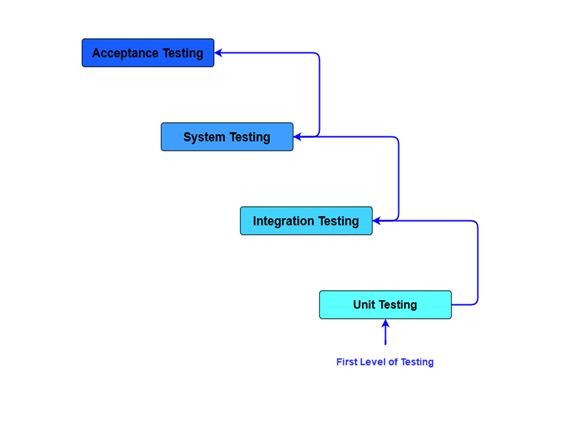| Usama Muhammad Ashraf
In general, there are four levels of testing: unit testing, integration testing, system testing and acceptance testing. The basic purpose of testing in different levels is to make software testing systematic and identify all possible test cases at a particular level.
Levels are designed to help the developers and testers to identify the missing areas of software. All the phases of SDLC go through the process of software testing levels. With the help of levels we can easily identify bugs in earlier stage and give the better quality software in the end.
Levels of Testing
Basically, there are four main levels of Software Testing
- Unit Testing
- Integration Testing
- System Testing
- Acceptance Testing
We will discuss all levels in detail in a separate Blogs which helps to understand the purpose of each level in software testing and how can we do it.
UNIT TESTING

What is Unit Testing?
Unit testing is a type of software testing in which individual units or components of software needs to be tested. The purpose of unit testing is to validate each unit of the software code performs as expected. Unit Testing is done during the time of development, usually developers perform unit testing to validate each unit and identify bugs in it before the Integration. A unit can be anything like function, method, object or module.
Unit Testing is technique of White Box testing, because in unit testing developers test the code to make sure the functionality performs as expected with this code run. Due to time crunch developers doesn’t give more time to it that’s why QA Engineers perform unit testing. But the developer is the best tester of Unit Testing to identify their faults in the code.
Importance of Unit Testing
Unit Testing is important because sometimes developers try to save their time and doing minimal testing on individual units and after that inappropriate unit testing leads to high Bugs or Defects fixes in System and Integration testing. If proper unit testing is done in early stage of development, then it saves time and cost in the end which is good for the team.
Here are the key reasons to do unit testing in early development stage:
- It helps to fix bugs earlier in starting phase of SDLC and save time.
- It helps the developers to find out bugs in the code and enables them to make changes before given the release to QA.
- It gives more clarity of each unit implementation.
- Good unit test case serves as project documentation
Unit Testing Techniques
Unit testing techniques can be categorized into three categories:
- Black box testing that involves the testing of user interface with input and output. It is used to verify that basic functionality of the app or software is working or not.
- White box testing that involves the testing the functional behavior of the application with the minor changes in the code structure.
- Gray box testing that involves the execution of test suites, test cases and preform risk analysis
Following Code coverage testing techniques used in unit testing to verify the functionality of each unit:
- Statement Coverage
- Decision Coverage
- Branch Coverage
- Condition Coverage
- Finite State Machine Coverage
Best Practices to Perform Unit Testing
- Unit Test Cases must be independent. Change in any unit doesn’t affect any other units
- Test only one code at a time. Means you need to test single unit at a time to give accuracy in code
- Follow consistent and clear naming conventions for your unit tests
- Bugs identified during unit testing must be fixed before going to a next phase of SDLC or before going to implementation of another unit
- In Unit Testing all basic bugs or defects must be identified and fixed
- At the time of implementation of Unit, requirements must be clear regarding the working unit
Advantages of Unit Testing
- Unit testing helps to find the bugs or defects in earlier stage, If bugs are not caught in earlier stages then will create problem in further stages.
- In Unit testing, developers easily find their mistakes in a code with each unit running cycle
- Unit testing makes the process of debugging easier
- Unit testing helps to find the unit interface and creates documentation which is used for mapping the requirements of system with Client requirements
Disadvantages of Unit Testing
- Sometimes, unit testing is time consuming activity. It takes more time of developer to identify the problem
- In Unit testing we cannot make sure the UI of the software is perfect or not, it is only focus on the functionality of the software
- Unit testing can’t be expected to catch every error in a program.
- It is totally focus on unit of code. Hence it can’t catch integration errors or broad system level errors
Conclusion
The conclusion or the summary of the above overall discussion is that Unit testing is the basic type of testing which needs to be done in earlier stage to identify bugs and fix it before given the build. Normally, developers done the unit testing from their ends but sometimes QA engineer also did it. The main purpose of the Unit Testing is to identify the bugs or defects in early stages which can create much bigger problem after the integration of units.
Join us next time, as we continue our journey of learning canvas apps.Click here to learn more about Imperium's Power Apps Services. We hope this information was useful, and we look forward to sharing more insights into the Power Platform world.

